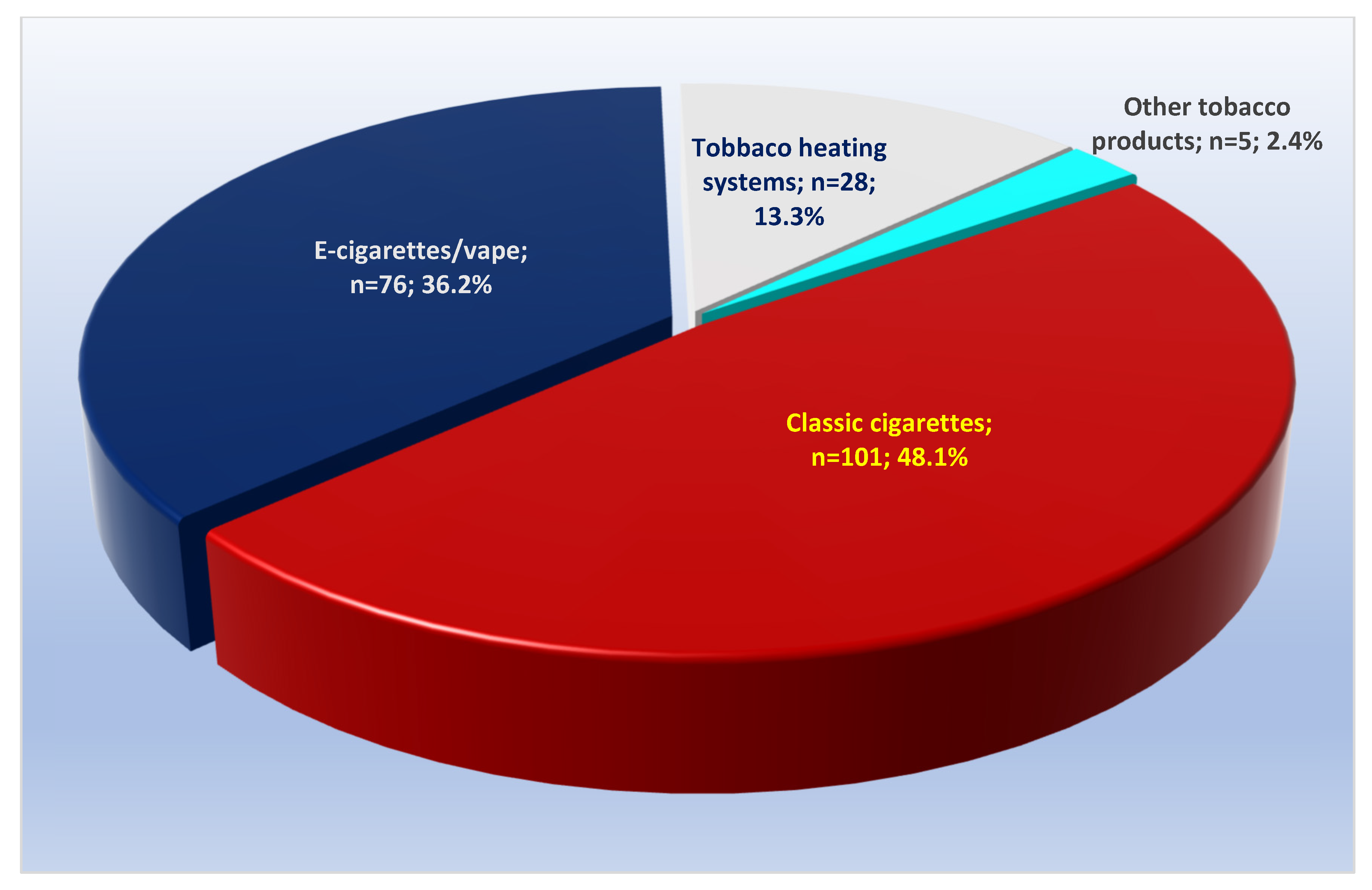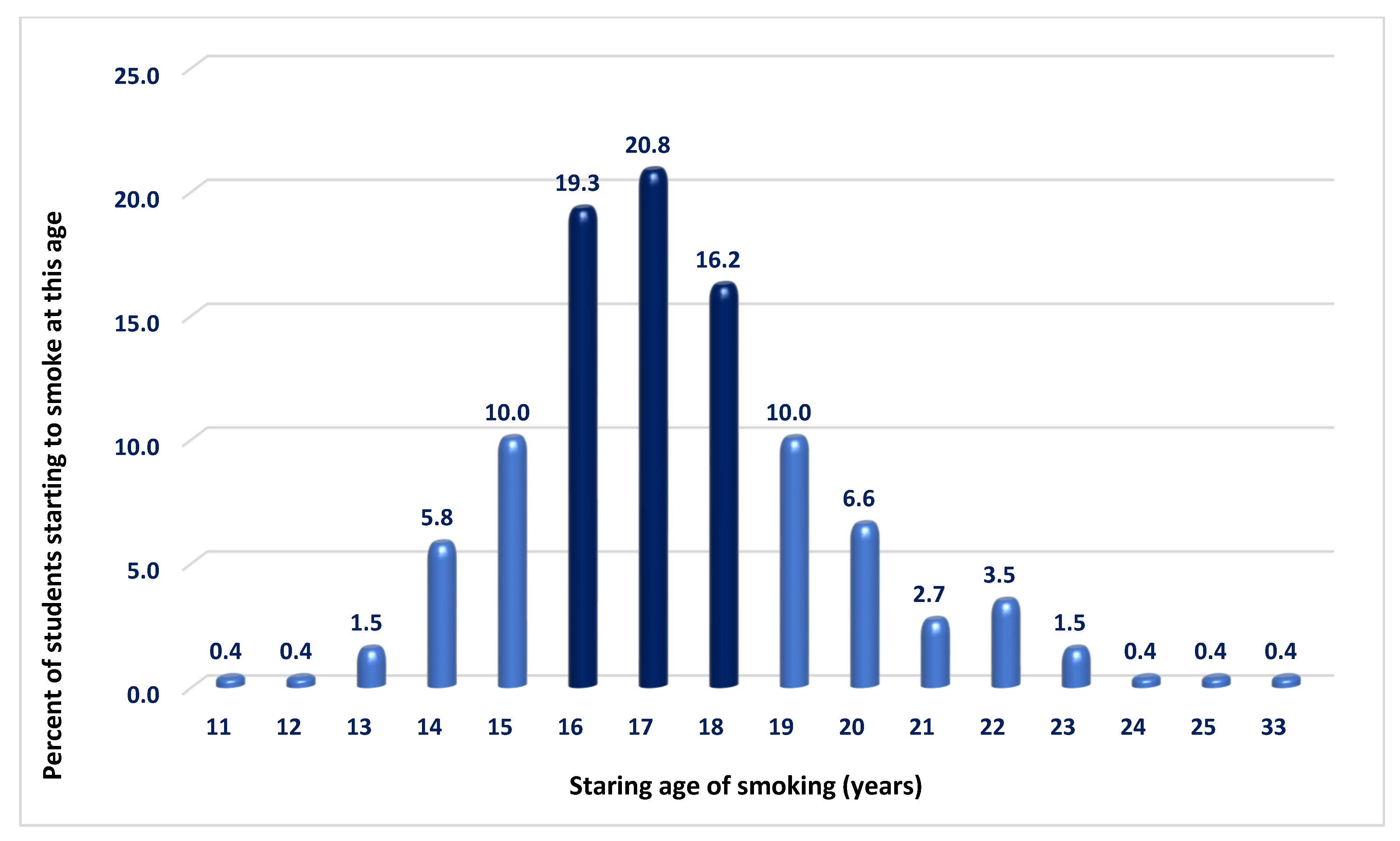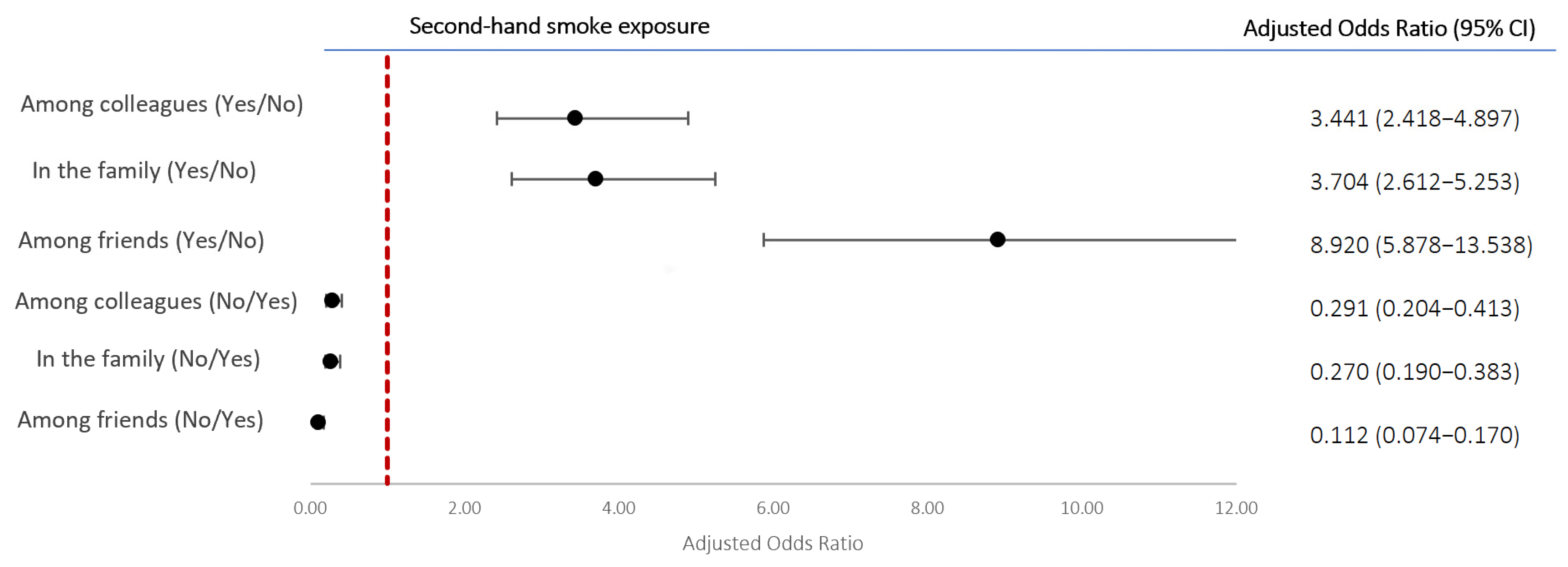Smoking Behavior, Exposure to Second-Hand Smoke, and Attitudes Among Bulgarian and Foreign Medical Students
Abstract
1. Introduction
2. Materials and Methods
2.1. Study Design
2.2. Participants
2.3. Statistical Methods
3. Results
3.1. Sociodemographic Characteristics of the Participants
3.2. Smoking Status
3.3. Cessation of Smoking
3.4. Tobacco Products Used
3.5. Starting Age, Duration of Smoking, and Pack-Years
3.6. Second-Hand Smoke in Social Circles and Influence on Smoking
3.7. Attitudes Toward Misconceptions of “Safe” Ways of Smoking and Associations with Smoking Status
3.8. Perceived Effects of Smoking on Health
4. Discussion
5. Conclusions
Supplementary Materials
Author Contributions
Funding
Institutional Review Board Statement
Informed Consent Statement
Data Availability Statement
Acknowledgments
Conflicts of Interest
Abbreviations
| CI | Confidence Interval |
| CVDs | Cardiovascular Diseases |
| EU | European Union |
| ICD | International Classification of Diseases |
| OECD | Organization for Economic Co-operation and Development |
| aOR | Adjusted Odds Ratio |
| THS | Tobacco Heating System |
| WHO | World Health Organization |
References
- World Health Organization. Cardiovascular Diseases; World Health Organization: Geneva, Switzerland, 2025; Available online: https://www.who.int/health-topics/cardiovascular-diseases#tab=tab_1 (accessed on 4 May 2025).
- Visseren, F.L.J.; Mach, F.; Smulders, Y.M.; Carballo, D.; Koskinas, K.C.; Bäck, M.; Benetos, A.; Biffi, A.; Boavida, J.-M.; Capodanno, D.; et al. 2021 ESC Guidelines on cardiovascular disease prevention in clinical practice. Eur. Heart J. 2021, 42, 3227–3337, Erratum in Eur. Heart J. 2022, 43, 4468. https://doi.org/10.1093/eurheartj/ehac458. [Google Scholar] [CrossRef] [PubMed]
- National Statistical Institute of Bulgaria. Mortality by Causes, Sex, Statistical Regions and Districts. Sofia: National Statistical Institute. Available online: https://www.nsi.bg/statistical-data/236/766 (accessed on 17 June 2025).
- European Commission. Health at a Glance: Europe 2024; Publications Office of the European Union: Luxembourg, 2024; Available online: https://health.ec.europa.eu/document/download/1e23af78-d146-4c84-be77-690fc6044655_en?filename=2024_healthatglance_rep_en.pdf (accessed on 6 May 2025).
- World Health Organization. WHO Report on the Global Tobacco Epidemic 2021: Addressing New and Emerging Products; WHO: Geneva, Switzerland, 2021; Available online: https://www.who.int/publications/i/item/9789240032095 (accessed on 4 May 2025).
- World Health Organization. Tobacco; World Health Organization: Geneva, Switzerland, 2025; Available online: https://www.who.int/news-room/fact-sheets/detail/tobacco (accessed on 26 April 2025).
- Bianco, E.; Skipalskyi, A.; Goma, F.; Odeh, H.; Hasegawa, K.; Zawawi, M.A.; Stoklosa, M.; Dalmau, R.; Dorotheo, E.U.; Berteletti, F.; et al. E-Cigarettes: A new threat to cardiovascular health—A World Heart Federation policy brief. Glob. Heart 2021, 16, 72. [Google Scholar] [CrossRef] [PubMed]
- Landman, S.T.; Dhaliwal, I.; Mackenzie, C.A.; Martinu, T.; Steel, A.; Bosma, K.J. Life-threatening bronchiolitis related to electronic cigarette use in a Canadian youth. CMAJ 2019, 191, E1321–E1331. [Google Scholar] [CrossRef]
- Ambrose, J.A.; Barua, R.S. The pathophysiology of cigarette smoking and cardiovascular disease: An update. J. Am. Coll. Cardiol. 2004, 43, 1731–1737. [Google Scholar] [CrossRef]
- Csordas, A.; Bernhard, D. The biology behind the atherothrombotic effects of cigarette smoke. Nat. Rev. Cardiol. 2013, 10, 219–230. [Google Scholar] [CrossRef]
- OECD/European Observatory on Health Systems and Policies. Bulgaria: Country Health Profile 2023, State of Health in the EU; OECD Publishing: Paris, France; European Observatory on Health Systems and Policies: Brussels, Belgium, 2023. [Google Scholar]
- Papadakis, S.; McEwen, A. Very Brief Advice on Smoking PLUS (VBA+); National Centre for Smoking Cessation and Training (NCSCT): Dorset, UK, 2021. [Google Scholar]
- Sample Size Calculator. Calculator.Net. Available online: https://www.calculator.net/sample-size-calculator.html (accessed on 4 May 2025).
- National Survey of Student Engagement. Response Rate FAQs. Bloomington (IN): Indiana University Center for Postsecondary Research. 2023. Available online: https://nsse.indiana.edu/nsse/psychometric-portfolio/responserate-faq.html (accessed on 1 August 2025).
- World Health Organization. MPOWER: A Policy Package to Reverse the Tobacco Epidemic; World Health Organization: Geneva, Switzerland, 2008; Available online: https://www.who.int/initiatives/mpower (accessed on 6 May 2025).
- Glahn, A.; Kyriakos, C.N.; Loghin, C.R.; Nguyen, D.; Starchenko, P.; Jimenez-Ruiz, C.; Faure, M.; Ward, B. Tobacco control achievements and priority areas in the WHO Europe Region: A review. Tob. Prev. Cessat. 2018, 4, 15. [Google Scholar] [CrossRef]
- Feliu, A.; Filippidis, F.T.; Joossens, L.; Fong, G.T.; Vardavas, C.I.; Baena, A.; Castellano, Y.; Martínez, C.; Fernández, E. Impact of tobacco control policies on smoking prevalence and quit ratios in 27 European Union countries from 2006 to 2014. Tob. Control 2019, 28, 101–109. [Google Scholar] [CrossRef] [PubMed]
- The Sofia Globe. Bulgarian MPs Pass Bill Introducing Graphic Tobacco Packaging [Internet]. 25 March 2016. Available online: https://sofiaglobe.com/2016/03/25/bulgarian-mps-pass-bill-introducing-graphic-tobacco-packaging/ (accessed on 13 August 2025).
- Global Action to End Smoking. Tobacco Control in Bulgaria. Available online: https://globalactiontoendsmoking.org/research/tobacco-around-the-world/bulgaria/ (accessed on 28 April 2025).
- Tobacco Atlas. Bulgaria: Country Factsheet. 2024. Available online: https://tobaccoatlas.org/factsheets/bulgaria/ (accessed on 28 April 2025).
- Sun, T.; Anandan, A.; Lim, C.C.W.; East, K.; Xu, S.S.; Quah, A.C.K.; Rutherford, B.N.; Johnson, B.; Qi, Y.; Stjepanovic, D.; et al. Global prevalence of heated tobacco product use, 2015–2022: A systematic review and meta-analysis. Addiction 2023, 118, 1430–1444. [Google Scholar] [CrossRef] [PubMed]
- Grand View Research. Heated Tobacco Products (HTPs) Market Size, Share & Trends Analysis Report. Available online: https://www.grandviewresearch.com/industry-analysis/heated-tobacco-products-htps-market (accessed on 6 May 2025).
- World Health Organization. 2 December 2020. New WHO Report Reveals that While Smoking Continues to Decline Among European Adolescents, the Use of Electronic Cigarettes by Young People Is on the Rise. Available online: https://www.who.int/europe/news-room/02-12-2020-new-who-report-reveals-that-while-smoking-continues-to-decline-among-european-adolescents-the-use-of-electronic-cigarettes-by-young-people-is-on-the-rise (accessed on 25 April 2025).
- Shrivastav, R.; Nazar, G.P.; Stigler, M.H.; Arora, M. Health promotion for primordial prevention of tobacco use. Glob. Heart 2012, 7, 143–150. [Google Scholar] [CrossRef] [PubMed][Green Version]
- Selph, S.; Patnode, C.; Bailey, S.R.; Pappas, M.; Stoner, R.; Chou, R. Primary Care-Relevant Interventions for Tobacco and Nicotine Use Prevention and Cessation in Children and Adolescents: Updated Evidence Report and Systematic Review for the US Preventive Services Task Force. JAMA 2020, 323, 1599–1608. [Google Scholar] [CrossRef] [PubMed]
- Racic, M.; Tanovic, S.; Joksimovic, V.R.; Joksimovic, B.N.; Ristic, S. Prevalence and determinants of smoking initiation among school students in Bosnia and Herzegovina. Int. J. Adolesc. Med. Heal. 2015, 27, 397–403. [Google Scholar] [CrossRef] [PubMed]
- Yang, X.; Yan, Z.; Xu, G.; Tan, Y.; Zhu, J. How secondhand smoke exposure affects tobacco use and smoking susceptibility of adolescents: Sex and school differences. Tob. Induc. Dis. 2021, 19, 68. [Google Scholar] [CrossRef] [PubMed]



| Characteristics | Bulgarian Students (n = 563) | Foreign Students (n = 500) | p | ||
|---|---|---|---|---|---|
| SD | SD | ||||
| Age (years) | 21.85 | 2.39 | 22.12 | 2.59 | 0.055 |
| Sex | n | % | n | % | |
| Male | 223 | 39.6 | 194 | 38.8 | 0.801 |
| Female | 340 | 60.4 | 306 | 61.2 | |
| University Year | 0.007 | ||||
| I | 114 | 20.2 | 96 | 19.2 | 0.683 |
| II | 100 | 17.8 | 60 | 12.0 | 0.008 |
| III | 51 | 9.1 | 73 | 14.6 | 0.005 |
| IV | 173 | 30.7 | 139 | 27.8 | 0.300 |
| V | 63 | 11.2 | 62 | 12.4 | 0.545 |
| VI | 62 | 11.0 | 70 | 14.0 | 0.139 |
| Group | Answers | Bulgarian Students | Foreign Students | p | ||
|---|---|---|---|---|---|---|
| n | % | n | % | |||
| All (n = 1063) | Yes | 139 | 24.7 | 70 | 14.0 | <0.001 |
| No | 398 | 70.7 | 406 | 81.2 | <0.001 | |
| Former smoker for at least 1 month | 10 | 1.8 | 11 | 2.2 | 0.641 | |
| Former smoker for at least 6 months | 7 | 1.2 | 4 | 0.8 | 0.516 | |
| Former smoker for at least 1 year | 9 | 1.6 | 9 | 1.8 | 0.801 | |
| Ever-smokers | 165 | 29.3 | 94 | 18.8 | <0.001 | |
| Men (n = 417) | Yes | 57 | 25.6 | 34 | 17.5 | 0.295 |
| No | 155 | 69.5 | 148 | 76.3 | ||
| Former smoker for at least 1 month | 5 | 2.2 | 4 | 2.1 | ||
| Former smoker for at least 6 months | 2 | 0.9 | 4 | 2.1 | ||
| Former smoker for at least 1 year | 4 | 1.8 | 4 | 2.1 | ||
| Ever-smokers | 68 | 30.5 | 46 | 23.7 | 0.125 | |
| Women (n = 646) | Yes | 82 | 24.1 | 36 | 11.8 | <0.001 |
| No | 243 | 71.5 | 258 | 84.3 | <0.001 | |
| Former smoker for at least 1 month | 5 | 1.5 | 7 | 2.3 | 0.455 | |
| Former smoker for at least 6 months | 5 | 1.5 | 0 | 0.0 | 0.032 | |
| Former smoker for at least 1 year | 5 | 1.5 | 5 | 1.6 | 0.918 | |
| Ever-smokers | 97 | 28.5 | 48 | 15.7 | <0.001 | |
| Environment | Bulgarian Students (n = 563) | Foreign Students (n = 500) | p | ||
|---|---|---|---|---|---|
| n | % | n | % | ||
| Family | 142 | 25.2 a | 66 | 13.2 a | <0.001 |
| Colleagues | 241 | 42.8 b | 140 | 28.0 b | <0.001 |
| Friends | 223 | 39.6 b | 149 | 29.8 b | <0.001 |
| Environment | Answers | Ever-Smokers (n = 259) | Non-Smokers (n = 804) | p | ||
|---|---|---|---|---|---|---|
| n | % | n | % | |||
| Family | Always | 30 | 11.6 | 44 | 5.5 | <0.001 |
| Frequently | 56 | 21.6 | 78 | 9.7 | <0.001 | |
| Sometimes | 55 | 21.2 | 100 | 12.4 | <0.001 | |
| Rarely | 33 | 12.7 | 123 | 15.3 | 0.304 | |
| Never | 85 | 32.8 | 459 | 57.1 | <0.001 | |
| Colleagues | Always | 52 | 20.1 | 69 | 8.6 | <0.001 |
| Frequently | 86 | 33.2 | 174 | 21.6 | <0.001 | |
| Sometimes | 64 | 24.7 | 203 | 25.2 | 0.872 | |
| Rarely | 44 | 17.0 | 177 | 22.0 | 0.085 | |
| Never | 13 | 5.0 | 181 | 22.5 | <0.001 | |
| Friends | Always | 66 | 25.5 | 50 | 6.2 | <0.001 |
| Frequently | 96 | 37.1 | 160 | 19.9 | <0.001 | |
| Sometimes | 65 | 25.1 | 207 | 25.7 | 0.847 | |
| Rarely | 26 | 10.0 | 181 | 22.5 | <0.001 | |
| Never | 6 | 2.3 | 206 | 25.6 | <0.001 | |
| Answers | n | % | Sp |
|---|---|---|---|
| Definitely negative | 76 | 36.4 | 3.3 |
| Mostly negative | 70 | 33.5 | 3.3 |
| Neither negative nor positive | 52 | 24.9 | 3.0 |
| Mostly positive | 10 | 4.8 | 1.5 |
| Definitely positive | 1 | 0.5 | 0.5 |
| Number of active smokers who responded | 209 |
Disclaimer/Publisher’s Note: The statements, opinions and data contained in all publications are solely those of the individual author(s) and contributor(s) and not of MDPI and/or the editor(s). MDPI and/or the editor(s) disclaim responsibility for any injury to people or property resulting from any ideas, methods, instructions or products referred to in the content. |
© 2025 by the authors. Licensee MDPI, Basel, Switzerland. This article is an open access article distributed under the terms and conditions of the Creative Commons Attribution (CC BY) license (https://creativecommons.org/licenses/by/4.0/).
Share and Cite
Gencheva, D.G.; Nikolov, F.P. Smoking Behavior, Exposure to Second-Hand Smoke, and Attitudes Among Bulgarian and Foreign Medical Students. Med. Sci. 2025, 13, 134. https://doi.org/10.3390/medsci13030134
Gencheva DG, Nikolov FP. Smoking Behavior, Exposure to Second-Hand Smoke, and Attitudes Among Bulgarian and Foreign Medical Students. Medical Sciences. 2025; 13(3):134. https://doi.org/10.3390/medsci13030134
Chicago/Turabian StyleGencheva, Dolina Gencheva, and Fedya Petrov Nikolov. 2025. "Smoking Behavior, Exposure to Second-Hand Smoke, and Attitudes Among Bulgarian and Foreign Medical Students" Medical Sciences 13, no. 3: 134. https://doi.org/10.3390/medsci13030134
APA StyleGencheva, D. G., & Nikolov, F. P. (2025). Smoking Behavior, Exposure to Second-Hand Smoke, and Attitudes Among Bulgarian and Foreign Medical Students. Medical Sciences, 13(3), 134. https://doi.org/10.3390/medsci13030134





